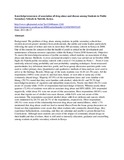Knowledge/awareness of association of drug abuse and disease among Students in Public Secondary Schools in Nairobi, Kenya.

View/
Date
2011-06-17Author
Lydia, W. Mwaura
Kiemo, Karatu
Ocharo, Robinson
Agaya, Benson
Type
ArticleLanguage
enMetadata
Show full item recordAbstract
Background: The problem of drug abuse among students in public secondary schools has recently received greater attention from professionals, the public and some leaders particularly following the spate of strikes and riots in more than 300 secondary schools in Kenya in 2008. One of the reasons for concern is that the health of youth is critical in the development and maintenance of human resource capacities within the Kenya Vision 2030 framework.
Objective: To assess the knowledge/awareness of public secondary school students on association of drug abuse and disease.
Methods: A cross-sectional descriptive study was carried out in October 2008. Eight (8) Nairobi public secondary schools with a total of 116 students in Form 1 – Form 4 were randomly selected using probability and non-probability sampling techniques. Semi-structured questionnaire, key informant interview guide, and focus group discussion question guide were used to collect primary data. Quantitative and qualitative methods of data analysis were used to arrive at the findings.
Results: Mean age of the study students was 16.44 (±1.39) years. All the respondents (100%) were aware of, and had seen, heard, or were able to name any of the commonly abused drugs. Majority (87.9%) of the respondents knew and were familiar with bhang, (70.7%) stated that they were familiar with alcohol, while 66.4% and 59.5% had knowledge/awareness of cigarettes and miraa/khat respectively. Nearly one third (30.2%) were aware of cocaine while 19.0% of respondents had knowledge of heroin. Whereas nearly three quarters (72.4%) of students were able to associate drug abuse and HIV/AIDS, 24% responded negatively, while about 3% were not aware of this association. Most respondents (88.8%) were aware that regular use of alcohol can cause disease, while 8.6% were not aware of this association. The respondents associated alcohol abuse with liver cirrhosis and cancers which were mentioned by 64.7% and 26.7% of the respondents, respectively. Most respondents (98.3%) were aware of the relationship between drug abuse and mental illness, while 1.7% mentioned that drug abuse could not lead to mental illness.From the focus group discussion we found out that respondents were aware that when students take commonly abused drugs, they experience hallucinations, screaming, and they are unkempt and unable to groom themselves.
Conclusions: Although most students are aware of the impact of commonly abused drugs on their health and that of others, there is still need to intensify education, guidance and counselling among students in public secondary schools in Kenya
URI
http://www.ajhsjournal.or.ke/?p=1244#more-1244http://erepository.uonbi.ac.ke:8080/xmlui/handle/123456789/55245
Citation
Lydia W. Mwaura, Karatu Kiemo, Robinson Ocharo, Benson Agaya. (2011). Knowledge/awareness of association of drug abuse and disease among Students in Public Secondary Schools in Nairobi, Kenya. African Journal of Health SciencesPublisher
University of Nairobi, Department of Sociology and Social Work
